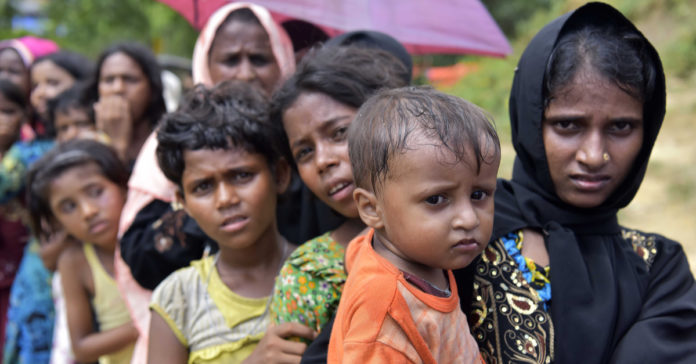As the ongoing genocide against Rohingya Muslims in Myanmar gains increasing media attention, pundits and laymen alike must understand the current crisis from the perspective of an emerging cold war between the United States and China, writes Najm Al-Din.
Like any geopolitical dynamic, analysing the Rohingya crisis beyond the conventional narrative is essential, seeing as the situation is far more multifaceted than peripheral observers would assume.
As Muslims who have been conveniently utilised as pawns in the War on Terror, it’s in our interest to keep abreast of any nefarious political design which external actors have for the region.
With the oppression of Rohingyas suddenly receiving significant international exposure on mainstream media, this ought to invoke our scepticism and encourage efforts to place the conflict in a meaningful context, seeing as the “presstitute” have a proven track record of being the propagandistic mouthpiece of the powers that be in most modern day contexts.
US-China Cold War
Myanmar has all the hallmarks of a proxy Cold War between the US and China. The US administration is hell-bent on containing China’s multipolar economic sphere of influence and this explains the American intrigue with Myanmar, seeing as the region is a strategic transit point for multi-billion dollar Chinese pipeline assets, alleviating Beijing’s reliance on the Strait of Malacca chokepoint.
Therefore, the US has set about co-opting the country’s military ranks by unleashing a hybrid war between Burmese nationalist proxies and a beleaguered Muslim Rohingya minority in order to force the Myanmar leadership to reorient its policies in line with Washington’s agenda to disrupt the China-Myanmar Energy Corridor and One Belt One Road (OBOR) initiative.
Subscribe to our newsletter and stay updated on the latest news and updates from around the Muslim world!
The inter-communal clashes we’re witnessing in Myanmar today is a continuation of the colour revolutions which the US intelligence apparatus orchestrated in South America for decades.
The US is seeking the balkanization of Myanmar and will go on to create the political conditions which will eventually nurture a sub-autonomous Rohingyaland, all under the guise of liberal interventionism and human rights, masking the real geostrategic intent of destabilising the region and hindering China’s economic potential in the process by endangering the economic security of Beijing’s pipelines and potentially handing over the control of lucrative Chinese maritime routes to its proxy administrators.
In many ways, this was the US policy in Afghanistan during the 1980s revisited. Back then, diminishing the Soviet presence in Asia was central to America’s military strategy, and history is set to repeat itself as handpicked militias are being and will be inducted in Myanmar to ultimately throw a monkey wrench in China’s economic zones in the region.
Thus, Myanmar plays a pivotal geopolitical role for the US, and ethnic/religious fault lines will be exploited to its fullest to ensure that China’s transnational infrastructure projects are scuppered.
While China benefits from having a strategic ally (Myanmar) on India’s borders, the US has already set about disrupting this bilateral partnership between China and Myanmar, having influenced the Myanmar leadership to renege on previously agreed economic ventures with China worth billions.
“Identity federalism” – The partitioning of Myanmar
It remains to be seen whether Aung San Suu Kyi will play ball with Washington, but the expectation behind the scenes will be for her to deliberately convert the region into a springboard for US interests for leverage against China, by fuelling the demands for autonomy, independence, and federalisation among the ethnic majority at the centre, and the several minority groups in the region’s peripheries.
This identity federalism is ripe for foreign meddling and the Myanmar generals high up the military echelons will most likely agitate for this federalist solution to create internal disorganisation and ultimately divide and rule.
This will exacerbate the already entrenched feelings of identity separateness among the disparate inhabitants.
In the event that Suu Kyi gets out of pocket and decides on consolidating the partnership with China, there is no doubt the US will incentivise elements in the military through personal enrichment to manoeuvre around her leadership by manufacturing the idea of Myanmar being a Chinese satellite and trigger a wave of domestic disturbances against what many would perceive as a discredited leader.
War on Terror
The US-led War on Terror in Iraq and Syria should teach us not jump on any bandwagon without evaluating the stated goals and objectives of those to whom we are extending our support and prayers.
In Iraq and Syria, the US continue to exploit several fault lines along ethnic, tribal and religious lines, backing entities with disparate objectives, including secular Baathists, Kurdish communists, and proxy “Islamists” as part of its policy to fracture Arab states and grant Israel a carte blanche in the region.
Myanmar has all the hallmarks of a hybrid war and the emergence of nationalist and sponsored “Islamist” militias is all but inevitable, all of whom will declare noble goals of independence and liberation but will ultimately be directed to instigate a civil war at the behest of the US military industrial complex.
Expect the US hand to be present at every outbreak of hostility in the pogroms to prevent the formation of a cohesive front to resist the state sponsored oppression in Myanmar, which, as horrific as it sounds, is still at its embryonic stage.
It’s likely the Chinese will respond by creating pro-Beijing buffers on its borders to safeguard its lucrative energy corridor which passes through rebel lines in the deeply fractured Shan and Rakhine states to counter any nefarious US ambitions on its bordering territories. Time will tell whether the military generals in Myanmar insist on protecting Chinese investments or pursue the American ambition in exchange for vested economic interests from its financial patrons.
There are many other battlegrounds in this brewing civil war and all must be accounted for. Whether India enters the fray remains to be seen, but it appears New Delhi could eventually become embroiled in the conflict if the Kaladan Multi-Modal Transit Transport Program comes under threat.
Rohingya resistance
Unless the Rohingyan resistance remains unaffiliated from the international powerbrokers, and adopts an uncompromising and clearly delineated framework of policies and objectives which conform with the aspirations of its people, then it would be politically naive to accept and encourage “diplomatic” efforts to resolve the crisis.
If the history of US interference is any indication, proxy militias will try to hijack the Rohingya cause and we only advocate on their behalf at our peril.
The destabilisation scenarios in Myanmar are numerous and the religious factions will feature considerably in the provocations against Chinese infrastructure, as part of the US Asian pivot and desired strategic shift to turn the tide against any pro-Chinese elements and facilitate the region’s devolution into a federation.
However, the only resistance which would deserve any genuine endorsement is the one which actively resists the genocide perpetrated by the Rakhine Burmese nationalists, whilst also challenging the US designs for the Bay of Bengal, in which the US is desperately seeking to establish a naval installation.
Already there are pundits, however well intentioned, calling for an intervention under the auspices of the UN, but throwing our weight and energy behind any faction which is unwittingly an accomplice for western interests will be a futile pursuit and most certainly a death trap, given the expediency with which the CIA continue to treat their screened insurgents and assets in Syria and other theatres of war.


















